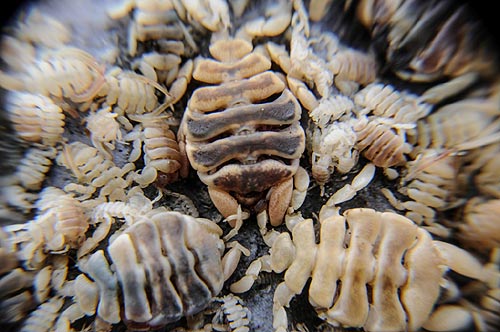The Ugliest Little Oregon / Washington Coast Critter You Rarely See
Published 12/15/20 at 6:55 PM PDT
By Oregon Coast Beach Connection staff

Includes exclusive listings; some specials in winter
In Cannon Beach:
Includes rentals not listed anywhere else
In Manzanita, Wheeler, Rockaway Beach:
Some specials for winter
In Pacific City, Oceanside:
Some specials for winter
In Lincoln City:
Some specials for winter
In Depoe Bay, Gleneden Beach:
Some specials for winter
In Newport:
Look for some specials
In Waldport
Some specials for winter
In Yachats, Florence
Some specials for winter
(Cannon Beach, Oregon) – They are crusty, creepy, and cringe-worthy. And they’re probably prime for a good street slam: “You so ugly yo mama don’t even love yo face.” They're everywhere on these beaches, however. You may bump into them in caves along the Oregon or Washington coast, such as at Hug Point near Cannon Beach, around Bandon, or Benson Beach at Washington’s Cape Disappointment, crawling around and looking like something quite primordial. (Photos courtesy Tiffany Boothe / Seaside Aquarium)
The name of the little bugger doesn’t help, either: the northern sea roach. They’re actually called the sea slater (Ligia pallasii) and they’re a large isopod, which means they’re a crustacean with seven pairs of legs. There are, however, several species along the beaches of Oregon or Washington that are similar; some have different colors and shapes, and some hang out in logs or other sections of the beach. In the case of the sea slater, they’re a sizable hideous creepy-crawly that inhabits the cliffs of beaches and their crevices, including caves.

Other names for them include the rock louse. Nope, not a single cute moniker in the lexicon for the little guys.
According to Seaside Aquarium’s Tiffany Boothe, they’re nocturnal, which means they generally only come out at night.
“They spend most of their day hiding in dark crevices and abandoned caves but at night they emerge in search of dead plants and animals to feast upon,” she said.
Not infrequently, if you overturn a large rock close to the cliffs or even sometimes on the sand, you’ll find one or two scurrying away. It’s certainly quite possible you’ll spot one lurking in cracks in rock cliffs if you look close enough. Sea slaters aren’t hiding in the sand though, they’re sticking to higher areas of the beaches like the rocks and cliffs.
“Though they may startle you as they scurry across rocks in the high intertidal zone, they are an important food source for birds and small crabs,” Boothe said. “Not all isopods are as ugly as the sea slater. Some, like the Rockweed Isopod (Pentidotea wosnesenkii) are actually quite beautiful and range in color from bright green to modeled pink.”
Since they’re higher-beach dwellers, they are not marine creatures. The sea northern sea roach is terrestrial, like most bugs, and they breath only air, Boothe said.
All if its legs are nearly identical in shape, with the first two modified to grasp things. They’re usually about an inch to an inch and a half long.
If they look a little familiar, they’re related to the “sow bugs” you’ll see in inland areas (like your yard) – a creature sometimes known as “rolly-polies."
Boothe admits they’re ugly and will remind people of cockroaches, but they are an important part of the beach ecosystem. Some of those even nastier dead things you encounter on the Oregon coast or Washington coast disappear with the help of these beachside weirdos.
The sea slater is found from Alaska all the way down to central California. More below
Oregon Coast Hotels in this area - Where to eat - Maps - Virtual Tours
Cannon Beach Lodging
Nehalem Bay Lodgings
Manzanita Hotels, Lodging
Three Capes Lodging
Pacific City Hotels, Lodging
Lincoln City Lodging
Depoe Bay Lodging
Newport Lodging
Waldport Lodging
Yachats Lodging
Oregon Coast Vacation Rentals
Oregon Coast Lodging Specials
Rockweed Isopod (Pentidotea wosnesenkii)

Also distantly related to the rock louse is Gray Whale Lice (Cyamus kessleri), which lives on whales. They're a good thing for the whale, actually.

Cave at Newport

Cave near Depoe Bay
More About Oregon Coast hotels, lodging.....
More About Oregon Coast Restaurants, Dining.....
LATEST Related Oregon Coast Articles
Bringing the Lincoln City events back to their roots
4.5 Quake Off S. Oregon Coast After A Week of Smaller Ones
Quakes on Dec. 15, 17, 20 and last night off Coos Bay, Bandon. Geology
Final Third of Oregon Coast Given Okay to Start Commercial Crabbing
Majority of the coast began crabbing last week. Marine sciences
Lassoing a Wayward Sea Lion Just Part of the Gig for Oregon Coast Deputies
Sea lion wandering near Newport / South Beach streets got some interesting looks. Marine sciences
Various Oregon Coast Road Issues At Least Partially Solved, Including OR 6
Hwy 6, 101 near Neskowin, others at least partially open. Tillamook, Coos Bay, Bandon. Traffic
Variety of Oregon State Parks Closed Due to Storm, from Coast to Columbia Gorge
Silverton, Estacada, Coastline and others: several parks damaged or closed. Weather
Flood Warnings Extended Into Afternoon Around Oregon, the Coast
Rivers near Lincoln City, Tillamook, Molalla, others at flood stage; wind damage
Winter Solstice and What It Brings to Oregon / Washington Coast Sunsets
Dec 21 is the solstice, bringing longer days and a sunset surprise. Weather
Back to Oregon Coast
Contact Advertise on BeachConnection.net
All Content, unless otherwise attributed, copyright BeachConnection.net Unauthorized use or publication is not permitted





















































